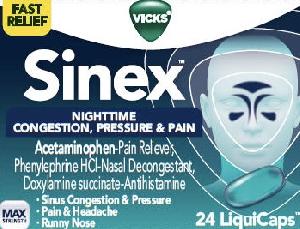Vicks Sinex Nighttime Interactions
There are 584 drugs known to interact with Vicks Sinex Nighttime (acetaminophen / doxylamine / phenylephrine), along with 15 disease interactions, and 1 alcohol/food interaction. Of the total drug interactions, 46 are major, 524 are moderate, and 14 are minor.
- View all 584 medications that may interact with Vicks Sinex Nighttime
- View Vicks Sinex Nighttime alcohol/food interactions (1)
- View Vicks Sinex Nighttime disease interactions (15)
Most frequently checked interactions
View interaction reports for Vicks Sinex Nighttime (acetaminophen / doxylamine / phenylephrine) and the medicines listed below.
- Abilify (aripiprazole)
- Advil (ibuprofen)
- Aleve (naproxen)
- allopurinol
- aspirin
- Aspirin Low Strength (aspirin)
- Azithromycin Dose Pack (azithromycin)
- Benadryl (diphenhydramine)
- Benadryl Allergy (diphenhydramine)
- BuSpar (buspirone)
- buspirone
- Celexa (citalopram)
- cetirizine
- Cipro (ciprofloxacin)
- Claritin (loratadine)
- clonazepam
- dextroamphetamine
- EpiPen (epinephrine)
- Excedrin Migraine (acetaminophen / aspirin / caffeine)
- Fish Oil (omega-3 polyunsaturated fatty acids)
- Flonase (fluticasone nasal)
- fluconazole
- fluticasone nasal
- lamotrigine
- lisinopril
- pantoprazole
- rosuvastatin
- Tylenol Extra Strength (acetaminophen)
- Vicks Sinex Daytime (acetaminophen / phenylephrine)
- Vitamin D3 (cholecalciferol)
Vicks Sinex Nighttime alcohol/food interactions
There is 1 alcohol/food interaction with Vicks Sinex Nighttime (acetaminophen / doxylamine / phenylephrine).
Vicks Sinex Nighttime disease interactions
There are 15 disease interactions with Vicks Sinex Nighttime (acetaminophen / doxylamine / phenylephrine) which include:
- alcoholism
- liver disease
- depression
- cardiovascular disease
- PKU
- anticholinergic effects
- asthma/COPD
- cardiovascular
- renal/liver disease
- glaucoma
- liver disease
- resp depression
- BPH
- diabetes
- glaucoma
More about Vicks Sinex Nighttime (acetaminophen / doxylamine / phenylephrine)
Related treatment guides
Drug Interaction Classification
| Highly clinically significant. Avoid combinations; the risk of the interaction outweighs the benefit. | |
| Moderately clinically significant. Usually avoid combinations; use it only under special circumstances. | |
| Minimally clinically significant. Minimize risk; assess risk and consider an alternative drug, take steps to circumvent the interaction risk and/or institute a monitoring plan. | |
| No interaction information available. |
See also:
Further information
Always consult your healthcare provider to ensure the information displayed on this page applies to your personal circumstances.


